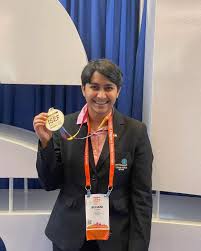Indian teen develops Paraspeak, an AI-powered translator for paralysis patients

Artificial intelligence is reshaping many industries, but its true power lies in solving real human problems. Pranet Khetan, an 11th-grade student from Gurgaon, has proved this with Paraspeak, an AI-powered device that helps people with paralysis and speech impairments communicate clearly. His creation focuses on converting slurred Hindi speech into understandable audio, offering hope to thousands of patients.
The Spark of Inspiration
Pranet’s idea took shape after a visit to a paralysis care center. He saw patients struggling to express even their simplest needs. Many of them had dysarthria, a condition that affects speech due to paralysis or neurological disorders like Parkinson’s. Their inability to communicate freely left them frustrated and isolated.
He quickly realized that existing speech recognition tools did not serve Hindi-speaking patients with slurred speech. Determined to create a solution, Pranet began designing an AI model that could understand distorted Hindi speech patterns. This drive to give people a voice resulted in Paraspeak.
What Sets Paraspeak Apart?
Most voice assistants, like Siri or Google Assistant, fail to recognize distorted speech. Paraspeak stands out because it uses an AI model trained specifically on Hindi dysarthric speech.
Pranet faced a major challenge—there was no dataset for this type of speech. He recorded 42 minutes of audio from 28 patients. To build a large enough training set, he used data augmentation and synthetic voice generation, expanding the dataset to 20 hours. This approach helped the AI model achieve strong accuracy in understanding slurred Hindi speech.
Compact, Affordable, and Practical
Paraspeak’s design focuses on ease of use. The device, which is about the size of a webcam, converts unclear speech into clear audio at the press of a button. Its price—around ₹2,000 plus a small monthly internet fee—makes it affordable for most families.
Patients simply speak into the device, and Paraspeak delivers clear, understandable words. This reduces confusion between patients and caregivers, ensuring smoother communication.
Recognitions and Milestones
Pranet’s invention has already received national and international recognition. Paraspeak earned praise at India’s IRIS National Science Fair for its innovation. It also secured a spot at the Regeneron International Science and Engineering Fair (ISEF) 2025, one of the most prestigious global platforms for young innovators.
What makes Pranet’s work even more special is his decision to keep the project open-source. By doing so, he encourages other developers and researchers to improve and adapt the technology for wider use.
AI and Assistive Technology
Paraspeak highlights how AI can empower people with disabilities. While AI often makes headlines for driverless cars or business analytics, its role in assistive communication is just as transformative.
For someone with paralysis, not being able to communicate can lead to emotional distress and isolation. Paraspeak changes this by allowing them to express themselves freely. By focusing on Hindi, Pranet also addresses the needs of a large part of India’s population, which existing English-focused solutions often overlook.
Future Goals
Pranet plans to expand Paraspeak beyond Hindi. His vision is to support multiple Indian languages so that millions of people across the country can benefit. He also wants to improve the AI model to handle more complex speech impairments and integrate the technology into mobile and wearable devices.
Globally, millions of people face communication challenges due to neurological conditions. Affordable solutions like Paraspeak could become essential tools in healthcare and rehabilitation centers worldwide.
A Young Innovator’s Impact
Pranet’s work proves that empathy and technology can create powerful solutions. At only 16, he has built a tool that could change countless lives. Paraspeak isn’t just about AI—it’s about restoring dignity and confidence to people who find it difficult to be understood.






